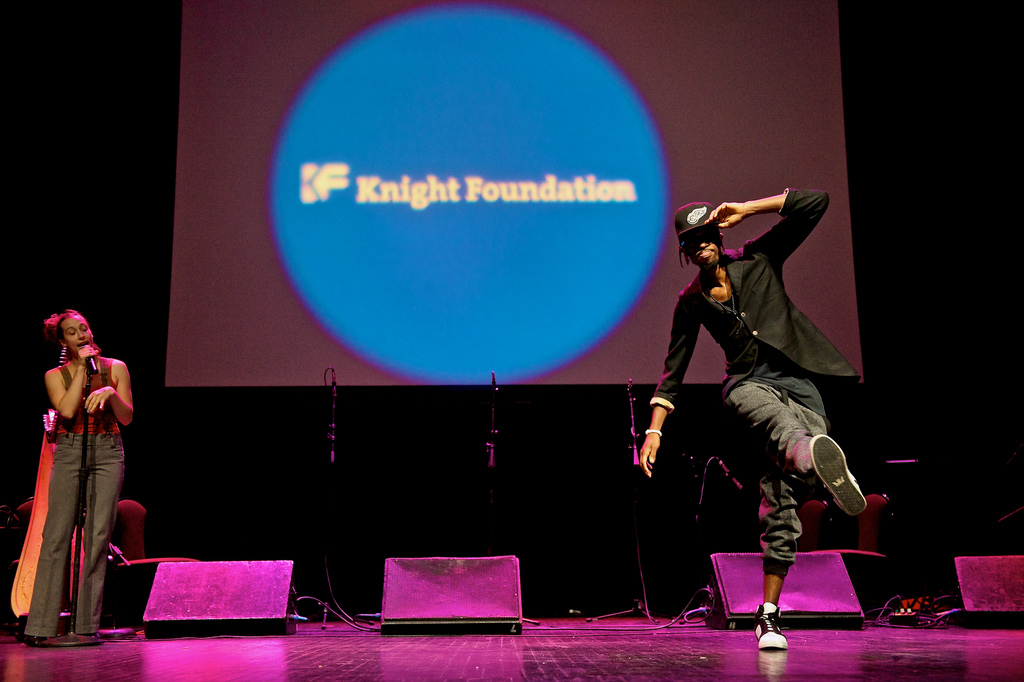
Detroit’s Jit gets night in spotlight with new documentary
Photo credit: Knight Foundation on Flickr.
Growing up in a hardscrabble swath of Detroit’s west side, Haleem Rasul had a start in life that wasn’t all that auspicious. Dance was his escape.
Rasul’s cousin got him into Breaking and Popping, dance forms popularized on the East and West coasts. But Rasul fell for the Jit, so much so that he got in touch with the McGhee brothers who originated the dance in Detroit in the mid-1970s.
A series of filmed interviews with the three brothers led to the documentary, “Jitterbugs: Pioneers of the Jit,” which debuts Friday at the Detroit Institute of Arts. The event, sponsored in part by the John S. and James L. Knight Foundation, is free with museum admission.
The movie, which took five years to make, includes appearances by luminaries such as Motown singer Kim Weston, who supported the brothers, as well as footage of the McGhees performing at local parties and events like festivals and auto shows throughout the mid 1980s. It also includes a bonus instructional on Jit steps and style, so anyone can learn the dance.
Rasul, 36, said the film chronicles how pioneers Johnny, Tracy and James McGhee gained local stardom only to fade from the klieg lights, leaving a rich legacy. The brothers are scheduled to perform at the premiere, along with other area dance groups including locally prominent Jit forerunners. The event, called “Jit Happens at the DIA,” also will feature top acts that have helped spread the Jit’s influence beyond the Detroit area.
The dance, which predates the popularity of techno music, which most people Jit to, is based exclusively on footwork.
Rasul said he had been blown away by the early interviews, although it took him a while to figure out how best to present them other than to post raw footage online.
“As I was getting into it, I was like, wow,” he said. “I just kept getting more and more good stuff, and found out the brothers had all this cool video of them performing everywhere, and then we found Kim Weston and other people, and the whole project just took off, taking on a life of its own.”
The project had come about innocently enough. In conversations Rasul had, as he got deeper into Jitting, the McGhee name often arose. The brothers eventually learned of Rasul’s inquiries, and sought him out themselves. By this time, Rasul had been conducting dance workshops abroad, eventually teaching for stints in Sweden and China. He also competed in Breaking competitions nationwide.
“That’s when I found out they weren’t doing the Jit anywhere else,” said Rasul, who has received no formal dance training, though has a degree in graphic design. “I started wondering if Detroit had its own dance styles.”
In the course of filming, he learned that most people associate “jitterbug” with swing dance, as he initially did. In Detroit’s urban core, the term instead connoted something along the lines of street life.
“A lot of contemporaries, these new cats, they don’t know that connection,” said Rasul, who works part time in custom car kit design, heads his own dance company called Hardcore Detroit, and produces Jit-related merchandising material.
Last year, Rasul won a $12,000 grant through the Knight Arts Challenge to help finance the documentary, which he hopes will encourage more people to learn, enjoy and keep Jitting alive. “I just want to expose to people who don’t know about the Jit, on a grand platform.”
Rasul, who lives in Detroit’s Midtown, said the south side of Chicago is generally considered the nation’s footwork capital. “But we want to be recognized for putting that in the game first, which is one of the main reasons I did the film,” he said. “They’re jitting in other cities now.”
Related link: “Detroit dance style the subject of a new documentary.”
Recent Content
-
Artsarticle ·
-
Artsarticle ·
-
Artsarticle ·

